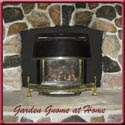
Sunday, March 23, 2008
Monday, March 17, 2008
Sunday, March 16, 2008
Fun With Paint
When we moved here last year we knew right off the bat that both bathrooms would need complete gutting and there would a kitchen renovation to fit our appliances, replace the countertop and backsplash and while not replacing the cabinets the cabinet doors and hardware would likely be replaced. So inside we knew we were facing some rather expensive changes. But what about the other rooms? Upstairs while gorgeous had very dated wallpaper in dirty taupe tones. The larger upper bedroom had deep rose with metallic gold floral wallpaper I actually like but according to everyone else it looks like a bordello. The smaller upper bedroom was poorly painted in two tone faux feather method. The dominant feature throughout the house is wood and lots of it with the family room and kitchen having wood wainscotting and wood beamed ceilings. The stairwell is wood. Aside of wood the next dominant feature in the family room is a floor to ceiling fieldstone fireplace. The challenge would be to keep the cottage feel while highlighting the wood and because of the design of the house keep the colours flowing nicely.
Freshening up the look of a room or giving it a whole new look is oh so easy and inexpensive with paint. It is the ultimate DIY project. If you don't like the results simply repaint. Online tools make it easy to choose paint colours and mood as well as coordinate your colours. You can even use your own photographs to see what the colours will look like in your room. The best part is you can do this all from the comforts of your home, tweaking until you get just the right look. Then print off the worksheet and head to your local paint store. My Colour Scheme
My Colour Scheme
We have a beautiful water view that changes daily taking on a life of its own. I really wanted the indoor colours to reflect that. Taking from the colour in the old wallpaper I settled on Country Mist from Behr, the lightest of the bluish greens on the paint chip card. The original colour was chose from paint chips at Home Depot. Home Depot has a computerized colour tool called ColorSmart for Behr paint. ColorSmart can be found online on the Behr website. Using the online version is nice because you can choose and co-ordinate your colours from the comfort of your home. You can try the colours on your own rooms $4.95 (one year subscription) or use generic rooms to get an idea of how the colours will look. If you are doing a lot of decorating, the one year subscription is well worth it since you will see how the colours look on your own rooms.
The first colour, Country Mist was used on the lower level family room walls, kitchen wall, and upper level games room. I used the medium green, Tide Pools on the deep windows sills and patio surround on the lower level and on the five smaller walls of the connecting entry/landing. I painted the entry door with the darkest green, Marina Isle. And there is where everything stopped. Preparing Main Landing Wall
Preparing Main Landing Wall
Technically the side entry that connects the upper level to the lower level is the only room on this level. It isn't calculated in with square footage something I don't understand. The walk-in pantry on the lower level is under the landing. The dark wood wainscotting on the walls go down the stairs and continues in the lower family room and connecting kitchen wall. The family room and kitchen have to be treated as one because of the design. The heavy bannister is a nice accent tying in the upper and lower levels. When we painted the lower level walls in Country Mist we did not have an actual colour picked out for the large upper room directly off the upper stains and to the right. Only the upper wall of this room above the landing is shown. I really wanted an accent mural on the large wall to the left done in muted tones sort of fantasy water themed. This room is actually supposed to be the good livingroom but we are really leaning towards putting a custom made pool table in there. I knew I didn't want the same greens but whatever colour I chose for that room had to flow into the connecting games room and the landing. So there it sat unfinished and undecided for about 6 months.
I searched unsuccessfully for a mural for the large wall of the landing. Then I got lucky and as posted in a previous entry, I had a break through when I found the perfect border that not only had all the colours that would work in the rooms but also had the nautical theme. Once the border was up in the lower level, we liked it enough to paint the large landing wall in Country Mist and trim the entire landing with the border to unify both levels. Unifying is important because the landing is quite visible from the lower level. Large Wall Finished
Large Wall Finished
Pictured here is one view of the landing showing the finished large wall and two of the smaller walls. The end of the bannister to the right (not shown) opens onto the end of large room where the games room joins. So the landing while being quite visible from the lower level is even more visible from the games room and large possible pool room to the left (not shown). The colour for the large room is Cumberland Fog, shown on the wall over landing. Choosing this colour was very simple using the border and the ColorSmart tool.
I went to the Behr site and started the ColorSmart tool then chose "select by Color name/number". I typed in the name Country Mist which took me to the next step where I could add colours from the names on the paint chips. Once all three colours were selected I chose which colour was the dominant colour and clicked select to coordinate. This brought up suggestions for a fourth coordinating colour. To get an idea of how the colours would look on the wall, I clicked on preview. As simple as clicking on the desired colour the clicking where I wanted it on the picture gave a good visual of how the room would look. From there I saved the project online (need to register) and printed a copy that shows the paint chips, colour names/numbers and picture of the project.
Comments for Using ColorSmart: This online tool and I'm sure there are others can save you a lot of time and headaches. It gives you a way to try on the colour in your own rooms with the only investment of a small subscription fee that for many is less that a trip to the store. At the same time you aren't playing around with actual paint samples so you save there. I should point out that you can buy small paint samples to try as well but this allows you to narrow down your choices before buying even the samples. Another advantage is being able to save your work online so you can modify as often as you want and unlike being in the store you have the room right ready to help make the decisions. If using your own photos be sure to take several of the room in different light. If the room will have mainly natural light that is what you want to work with. Take your time to get good photos to work with. Another View
Another View
This view is from the end of the bannister on the upper level looking down onto the landing. I'm rather pleased with the effects of three shades of green in the landing with the Cumberland blue (top and to left) from the upper room to the left flowing nicely into the landing. The remaining element in the landing to be changed is the floor itself. We have decided on ceramic tile but have not decided on a colour yet. I'm impressed that the two rooms came together so fast once I gave up on finding a mural and going with repeating the border.
The online tool is something I will be using throughout the house. It really makes coordinating the paint colours from one room to the next almost fool proof. I'm now working on the colours for the two upper bedrooms that are connected to the large possible pool room via a spacious almost square hall. Through the double French door entrance to the hall from left to right is a large bedroom, bathroom, small bedroom and linen closet. The colour needs to be a connector as well. Using the ColorSmart tool, Pearl Drops looks to be a good choice.
So don't be afraid to experiment with colour. The online tools will let you do it easily with little cost. Who knows you may discover a whole new look for your room very different from what you were thinking. Have fun!
Garden Gnome
© 2007

Wednesday, March 5, 2008
Fourteen Tips for Curbing the Rising Food Dollar
If you have read my cooking blog, you will recognize this picture from my last entry. However, the picture goes nicely with today's entry on this blog. There has been a lot of talk about the cost of bread rising and sadly that is true. According to one Canadian source, the price of bread will be increasing by 25 to 30 percent. The price of wheat has increased along with the costs of transportation, farming and labour. That means anything made with wheat will also increase in price. At the same time, the cost of fuel has toppled over the $4 per gallon mark that will be sure to drive the prices of other foods up. Other sources are predicting a recession because of the rising food, gas and energy prices. Some of the groups I'm on are already reporting increases in the price of cooking oils, corn based products, coffee, dairy, produce and meats. So how are you going to deal with the rising food costs? Here are some of the things I've done consistently for years.
- garden - Remember the Victory Gardens? They were meant to take the demand off the public food supply during WWI and WWII by growing your own. Well the ideal is still sound practice but where it has improved is using the square foot gardening method and container gardening to maximize the yield for your space. Gardening tips can be found on my garden blog. With gardening comes excess produce so you need a way of preserving this excess for later used.
- food preserving - Preserving excess produce from the garden is a must. By far the easiest method is freezing but consider that once frozen you continue to pay for keeping that food frozen until you use it. Our freezer costs work out to about $200 per year and that is just to keep the food frozen. You are subject to any fluctuations in power. A long power outage will put your carefully preserved foods at risk to the point you could easily lose everything. Canning solves this problem and it works amazingly well for so many food. I can everything from dried beans to soups and stews to vegetables to sauces, jams, jellies, pickles, condiments and so much more. In most cases the cost per ml is a fraction of store bought. Next to canning is drying. This is cheap and easy to do with little equipment needed. Be sure to vacuum seal your dried goods to prevent any problems from humidity or insects. Once vacuum sealed the food should be stored in rodent proof containers.
- consider the cost of acquisition - Cost of acquiring food needs to be taken into consideration especially with the rising fuel costs. This adds to the cost per meal. Sorry guys, but I simply cannot handle the "weekly" grocery shopping trip and when you factor in the cost of gas shopping more than one store can easily eliminate any savings on actual groceries. I shop one basic grocery store and a farmer's market usually once per month unless something is on sale for a really good price but even then I will not make a special trip. I shop at a club warehouse store about once every three months. My husband will occasionally pick up milk or salad ingredients because he is within walking distance to the grocery store while at the office. Reduce the trip to the grocery store to the bare minimum if you want to save on the cost of food.
- buy in bulk - The best savings on meats, poultry, eggs, flours and so much more are realized when bough in bulk. On a larger scale buy meats as we do directly from the farmer. On a larger scale buy family sized packages of meat and break them down into desirable amounts. Shop the warehouse stores. This can save you a lot of money, well more than the cost of membership.
- buy locally - Buying locally gives you the freshest produce, meats, eggs and poultry without the high transportation costs. It keeps your neighbours working as well so buying locally not only saves you money but it is good for the community and environment.
- buy in season - Fruits and vegetables are cheaper when in season. A 50 lb bag of potatoes goes for $7.99 in season yet a 10 lb bag will cost as high as $2.99 out of season. It makes good sense to stock up in season for things like apples, potatoes, squashes, carrots and rutabagas as they will keep for a long time when stored in a cool, dark location. This is also the best time to buy extra for canning or freezing.
- shop the sales - This goes without saying but if you stock up during the sales you can save a lot of money. What you really need to do this is a well stocked pantry (see 12) so when the sales come along you are focusing on one thing only. The grocery stores here have been running dollar sales with items being sold for a dollar. While a good portion of these items are processed, snacky type foods (something to be avoided) there are still some good deals. One store now has regular ground beef ($1 per lb), hot house tomatoes ($1 per lb) seedless cucumbers ($1 each), celery ($1 each), green onions ($1 per bunch), leaf lettuce ($1), pork hocks ($1 per lb), pork riblets ($1 per lb) and Red Rose tea (36 for $1) along with all the other highly processed food items on sale for $1. This will warrant a stop when I'm in the area sometime before the end of the sale, yet I will not make a special trip. When I stop I will stock up on all of the above whether I need it or not with a budget of $60. I'll can up the ground beef, dry the celery, make soups and make a lot of salads. Aside of milk and a couple of things needed for entertaining, this will be my only grocery shopping this month yet my pantry will be replenished.
- shop factory outlets - Many food processing plants have factory outlets. While some of these outlets are restricted to employees others are open to the public. So if you live in an area where there is one or more food processing plants, consider buying your foods there. I can buy cra
- cook from scratch - This has to be one of the biggest food dollar savings. By cooking from scratch not only do you get healthier foods but you reduce packaging (environmentally friendly). Make your own quick meal starts and convenience foods. For ideas, check out my cooking blog. My favourite quick starts that I keep on hand either as home canned or frozen or both are: plain browned ground beef, seasoned ground beef, taco meat, sliced grilled chicken breasts, sloppy joe mix, home made meat balls and a large variety of home canned tomato sauces. There are several websites with recipes for making your own mixes. You can have the convenience of pre-made mixes by setting aside a couple of hours a month to make mixes that will cost a fraction of the price of pre-made mixes in the grocery stores. Think too of your wheat products. Cakes, cookies and breads are all considerably cheaper to make at home. A 10 kg (22 lb) of unbleached flour is currently costing me $7.99 with multi-grain, whole wheat and rye flours costing a bit more. At current prices of $2.49 for some breads (Italiano, Dempsters) that is only 3.2 loaves of bread yet one 10 kg bag will yield a lot more than 3 loaves of bread. I bake bread as needed that averages out to twice a week. Seriously, invest in the necessary tools and cook from scratch for ultimate savings.
- consider the cost of cooking - The cost of cooking is often overlooked as part of your food dollar but with rising costs in electricity and natural gas it really needs to be considered. Use a lid when ever possible as food does cook faster. My large burner is 2000 W which works out to an operating cost of 24¢ per hour. Even paring off 5 minutes from the cook time saves money. When cooking always cook extra especially when using the oven. It takes as much energy to cook one roast as it does two. Better yet toss in potatoes too. Whenever I use either the oven or grill there is the main meal being cooked along with the makings for another meal or sandwich meat or quick starts. My oven element is 2600 W which works out to an operating cost of 31¢ per hour. Using the oven (electric) and grill (natural gas) in this manner saves money. A counter top roaster (750 W, 9¢ per hour) and pressure cooker are two useful, money saving appliances when bulk cooking. Surprisingly, because of the length of time a slow cooker (215 - 325 W, 3 - 4¢ per hour) is on, it does not always save money. For example a roast in the counter top roaster will cost about 18¢ in electricity but using a slow cooker it will cost 24¢ and only 16¢ using a pressure cooker. I usually serve some type of salad with every dinner meal because not only is raw good for you, it doesn't cost anything to prepare besides refrigeration costs.
- reduce meat portions - North Americans really love their meat and in general eat larger portions than they should. A portion size should be about the size of your palm so even gradually cutting back the portion size will save money. Think soups, stews, casseroles and salads to reduce the amount of meat. Make your own stocks then use for cooking rice or flavouring mashed potatoes. Home made stocks are considerably cheaper than store bought and can be frozen or canned in smaller portions to use as required. Substitute beans for meat. For extra savings cook beans from dried. These taste so much better than store bought canned beans. Dried beans can be home canned for convenience at a cost considerably less expensive than store bought. Each 500 ml (pint) jar of home canned kidney beans cost me 6 cents and they are one of the easiest things to can with almost no prep. Replace expensive lunch meats with actual meats like turkey breast, meatloaf, chicken and roast beef. I often cook extra then slice the meat thin and vacuum seal into quart bags for sandwiches and wraps.
- a question of brand loyalty - This tends to be a personal choice but what many fail to realize is one food processing plant often puts out the same product under different labels. I know for a fact that one processing plant for tomatoes does a run of brand name whole tomatoes followed by three or four store brand names. They are the same tomatoes yet the brand name is more expensive! Now with this being said, I have to admit to being brand loyal for some things like cream cheese. In most cases there is little to no difference in brand name verses store brands other than brand names being more expensive. So do try the store brands for saving on food costs.
- shop unit prices - Every larger store has a cost per unit (eg. cost per ml, cost per ounce) on the shelf tag of the item. These are the prices to shop even if the item is on sale. Take a calculator with you and figure out the cost per unit for sale prices and for instances where the store does not give you the unit price. It does work out that sometimes the smaller package is cheaper per unit than the jumbo package.
- buy from the source - Buying meats, poultry, eggs and produce directly from the source can save you a lot of money especially when combined with buying in bulk. In most cases this means buying directly from the farmer or orchard but for those in urban areas may include farmers' markets. These tend to be the places to get the best prices and you can always do a little dickering. At the same time you end up with a fresher product for your money and in many cases you can buy organic and/or free rand so you are also ending up with a superior product for your dollar.
Garden Gnome
© 2007



















